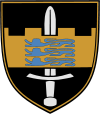Estonian Land Forces: Difference between revisions
No edit summary |
|||
| Line 67: | Line 67: | ||
*[[main battle tanks]]: ~50 units ([[Leopard 2]], most likely)<ref>[http://www.epl.ee/artikkel/576265 Estonia to purchase 50 tanks in the near future]</ref> |
*[[main battle tanks]]: ~50 units ([[Leopard 2]], most likely)<ref>[http://www.epl.ee/artikkel/576265 Estonia to purchase 50 tanks in the near future]</ref> |
||
;Armoured vehicles |
;Armoured vehicles |
||
*[[armoured personnel carrier]]s: |
*[[armoured personnel carrier]]s: 81 units ([[Sisu Pasi|Sisu XA-188]]) |
||
;Anti-tank systems<ref>[http://uudised.err.ee/index.php?06204594 Defence Forces seeking to purchase new grenade launchers from Spain]</ref> |
;Anti-tank systems<ref>[http://uudised.err.ee/index.php?06204594 Defence Forces seeking to purchase new grenade launchers from Spain]</ref> |
||
*[[C90-CR (M3)|C-90]] grenade launchers |
*[[C90-CR (M3)|C-90]] grenade launchers |
||
Revision as of 05:55, 9 October 2010
| Estonian Ground Force Maavägi | |
|---|---|
 Estonian Ground Force emblem | |
| Active | 1918–present |
| Country | |
| Role | Ground defence |
| Engagements | War of Independence Iraqi war (2003) Afghanistan War (2001) |
| Commanders | |
| Commander | Colonel Indrek Sirel |
The Estonian Ground Force, (Estonian: Maavägi) is the name of the unified ground forces among the Estonian Defence Forces where it has an offensive military formation role. It is currently also the largest military branch with the average size during the peacetime with around 6,000 soldiers, conscripts and officers.
The Maavägi development priorities are the capability to participate in missions outside the national territory and the capability to perform operations to protect the territory of Estonia, also in co-operation with the Allies. The Maavägi component of the operational structure consists of an infantry brigade and a homeland security structure. Deployable infantry battalion tactical group and some deployable CS, CSS units will developed in the Army structure in accordance with NATO Force Proposals requirements. Infantry brigade will act as a training and support frame for deployable units. Homeland security structure units will have the capability to carry out territorial military tasks and support civil structures.
The Maavägi is structured according to the principle of a reserve force which means that the main part of the defence forces of the state are units in the reserve. For a state with few human and economic resources, a reserve force based on the will of defence of the citizens is the only viable form of national defence.
In peacetime the reservists conduct normal lives and the state takes care of their training and the procurement of equipment and weapons. In wartime the reservists are mobilized into military units. The reserve units are formed on the territorial principle, i.e. conscripts from one area are called up at one time to one unit and after service they are sent to the reserve as one unit. The Estonian Army is always in constant defence readiness in co-operation with the other services.
Organization
Peacetime structure

 1st Infantry Brigade (likely to be motorized with apc-s)
1st Infantry Brigade (likely to be motorized with apc-s)
 Scouts Battalion
Scouts Battalion Kalevi Infantry Battalion
Kalevi Infantry Battalion Logistics Battalion
Logistics Battalion
 Northeastern Defense District (Tapa)
Northeastern Defense District (Tapa)
 Engineer Battalion (Tapa)
Engineer Battalion (Tapa) 1st Artillery Battalion (Tapa)
1st Artillery Battalion (Tapa) Air Defence Battalion (Tapa)
Air Defence Battalion (Tapa) Central Training Area
Central Training Area Viru Infantry Battalion (Jõhvi)
Viru Infantry Battalion (Jõhvi)
- Northern Defense District (Tallinn)
 Signal and Staff Battalion
Signal and Staff Battalion Guard Battalion
Guard Battalion
- Southern Defense District (Tartu)
- Western Defense District (Pärnu)
Wartime structure
Since the Maavägi is based on the principles of the reserve army, during the wartime it can man and arm during the conflict the following wartime structure:
- 4 infantry brigades
- 3 air-defence battalions
- 2 engineerbattalions
- 3 artillery battalions
- 2 combat support service battalions
- 2 scoutscompanies
- 2 anti-tank companies
- 2 signalcompanies
Equipment
Since the restoration of the Estonian Defence Forces on September 3, 1991 the Maavägi has developed with a great deal.[1] Today the Ground Force operates with modern weapons and weapon-systems on foreign missions and future battlefields. Even though the current logistic support is still based on variety of different and mainly older Western vehicles, also former Soviet, the modernization of the army branch is in the national defence policy agenda. In recent years Estonia has purchased more modern transport vehicles for the armed forces of the republic.
Modernization
According to the long-term defence development plan the Ground Force is currently undergoing a modernization program. By the year 2018 the Ground Force is likely to be equipped with the modern tanks and infantry fighting vehicles along with the additional armoured personnel carriers.[2] The artillery capabilities were greatly increased in 2008 with the purchase of 122mm field howitzers from Finland.[3] The army is also planning to add some tactical air surveillance and transport capabilities in terms of helicopters. A partial list of planned new weapon purchases for the Defence Forces include:

- Armoured fighting vehicles[4]
- main battle tanks: ~50 units (Leopard 2, most likely)[5]
- Armoured vehicles
- armoured personnel carriers: 81 units (Sisu XA-188)
- Anti-tank systems[6]
- Anti-air systems[7]
- NASAMS medium to long range anti-air systems. (most likely)
- Aviation
See also
Notes
- ^ Eesti Kaitseväe ajalugu Mil.ee
- ^ The Long-Term Defence Development Plan
- ^ http://www.delfi.ee/news/paevauudised/eesti/article.php?id=21331721 Estonia purchasing howitzers from Finland
- ^ Estonia is about to build up its tank force
- ^ Estonia to purchase 50 tanks in the near future
- ^ Defence Forces seeking to purchase new grenade launchers from Spain
- ^ Estonia wants to buy new AA system
- ^ http://mil.ee/?id=3097
